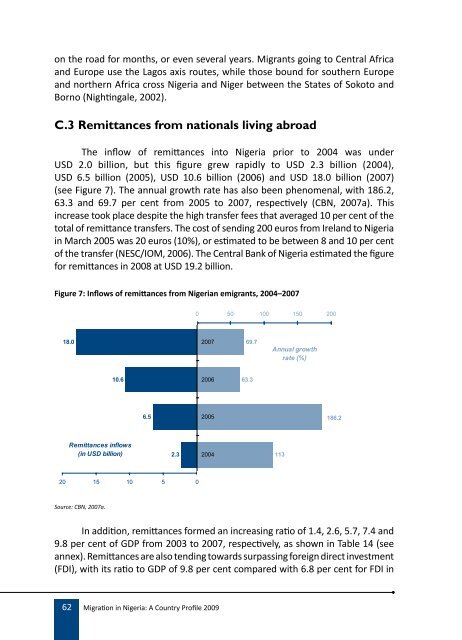Migration Profile on Nigeria - IOM Publications - International ...
Migration Profile on Nigeria - IOM Publications - International ...
Migration Profile on Nigeria - IOM Publications - International ...
You also want an ePaper? Increase the reach of your titles
YUMPU automatically turns print PDFs into web optimized ePapers that Google loves.
<strong>on</strong> the road for m<strong>on</strong>ths, or even several years. Migrants going to Central Africa<br />
and Europe use the Lagos axis routes, while those bound for southern Europe<br />
and northern Africa cross <strong>Nigeria</strong> and Niger between the States of Sokoto and<br />
Borno (Nightingale, 2002).<br />
c.3 remittances from nati<strong>on</strong>als living abroad<br />
The inflow of remittances into <strong>Nigeria</strong> prior to 2004 was under<br />
USD 2.0 billi<strong>on</strong>, but this figure grew rapidly to USD 2.3 billi<strong>on</strong> (2004),<br />
USD 6.5 billi<strong>on</strong> (2005), USD 10.6 billi<strong>on</strong> (2006) and USD 18.0 billi<strong>on</strong> (2007)<br />
(see Figure 7). The annual growth rate has also been phenomenal, with 186.2,<br />
63.3 and 69.7 per cent from 2005 to 2007, respectively (CBN, 2007a). This<br />
increase took place despite the high transfer fees that averaged 10 per cent of the<br />
total of remittance transfers. The cost of sending 200 euros from Ireland to <strong>Nigeria</strong><br />
in March 2005 was 20 euros (10%), or estimated to be between 8 and 10 per cent<br />
of the transfer (NESC/<strong>IOM</strong>, 2006). The Central Bank of <strong>Nigeria</strong> estimated the figure<br />
for remittances in 2008 at USD 19.2 billi<strong>on</strong>.<br />
Figure 7: Inflows of remittances from <strong>Nigeria</strong>n emigrants, 2004–2007<br />
Source: CBN, 2007a.<br />
In additi<strong>on</strong>, remittances formed an increasing ratio of 1.4, 2.6, 5.7, 7.4 and<br />
9.8 per cent of GDP from 2003 to 2007, respectively, as shown in Table 14 (see<br />
annex). Remittances are also tending towards surpassing foreign direct investment<br />
(FDI), with its ratio to GDP of 9.8 per cent compared with 6.8 per cent for FDI in<br />
62 <str<strong>on</strong>g>Migrati<strong>on</strong></str<strong>on</strong>g> in <strong>Nigeria</strong>: A Country <str<strong>on</strong>g>Profile</str<strong>on</strong>g> 2009

















